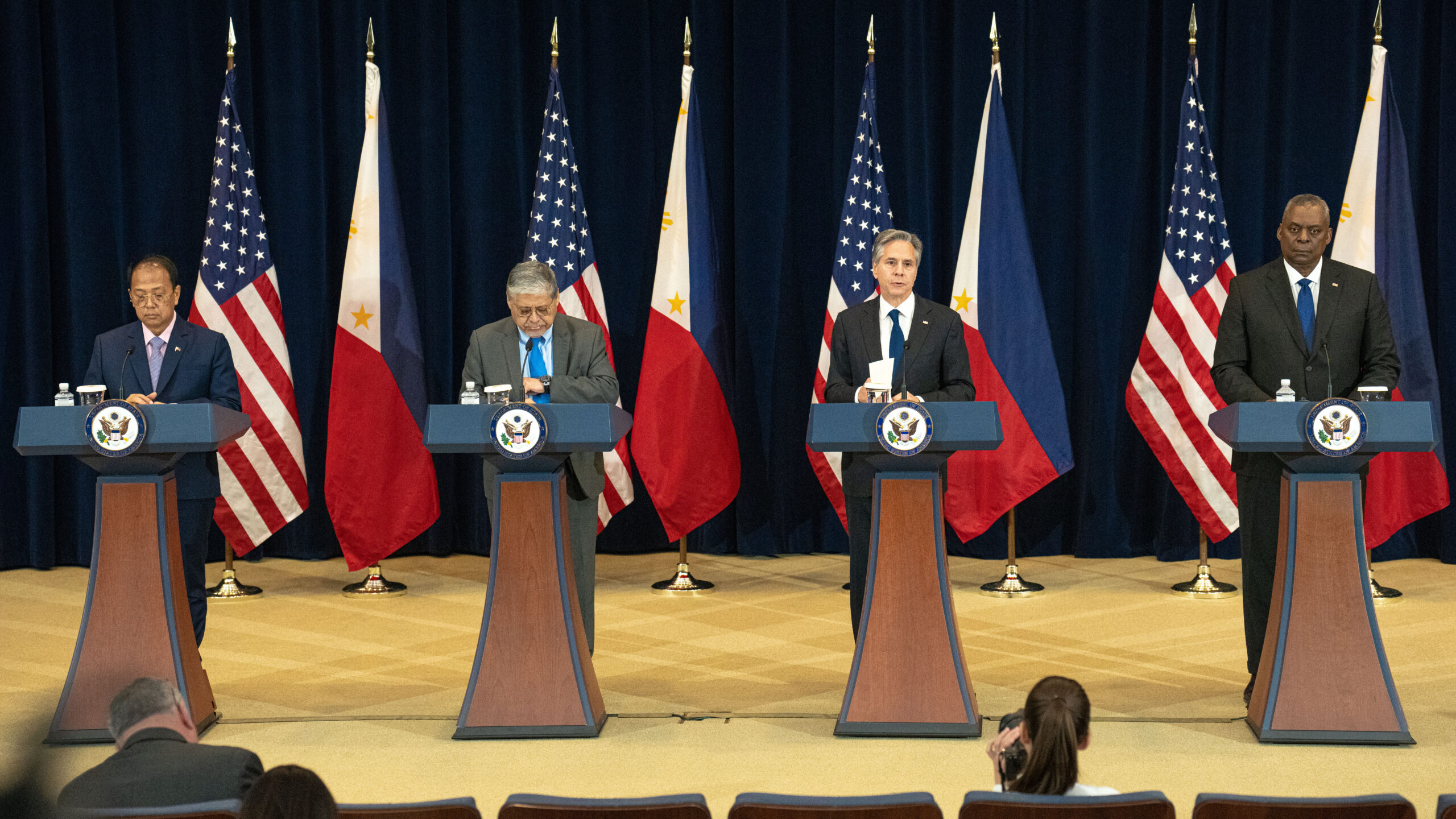
Secretary of State Antony J. Blinken participates in a joint press availability with Secretary of Defense Lloyd J. Austin III, Philippine Secretary of Foreign Affairs Enrique Manalo, and Philippine Senior Under Secretary and Officer in Charge of the Department of National Defense Carlito Galvez following the U.S.-Philippines 2+2 Ministerial Dialogue at the U.S. Department of State in Washington, D.C., on April 11, 2023. [State Department photo by Freddie Everett]
That news came at the end of a lengthy fact-sheet issued following the third US-Philippines Ministerial Dialogue, which saw a meeting between US Secretary of State Antony Blinken and Defense Secretary Lloyd Austin and their Philippine counterparts, Secretary of Foreign Affairs Manalo and Philippines Secretary of National Defense Galvez.
The two countries also announced they will resume joint Freedom-of-Navigation Operations (FONOPs) sailings in the South China Sea, where China has violated the Philippine’s Exclusive Economic Zone and territorial claims. A UN tribunal ruled that China has no legal claim to the South China Sea.
“Like minded partners” may join those patrols later this year, the official Phillipine News Agency reported. There are indications, but no confirmation, that Australia may take part.
The behind-closed-doors meetings included broader discussions on “near-term plans to complete a security-sector assistance roadmap to support the delivery of priority defense platforms over the next five to 10 years, including radar, unmanned aerial systems, military transport aircraft and coastal- and air-defense systems,” Austin said in public comments.
RELATED: Following new basing agreement, Berger hosts Philippine Marine Corps chief
The small multi-role fighter program had been announced, though not funded, by the previous Philippine government of Rodrigo Duterte. At the time it was announced it would comprise 12 Saab JAS 39 Gripen C/Ds or Lockheed Martin F-16 Vipers. The joint statement could be seen as an indication that the F-16s have won the day over their Swedish-made competition, although it is common for the US to lay out a way forward for future Foreign Military Sales cases before a final decision has been made. The fact sheet also noted a previous pledge from the US of $100 million in Foreign Military Financing to help pay for new medium-lift helicopters.
The meeting in Washington came following several months of renewed military relations between the two sides. In February, it was announced that the US would expand its military presence under the aegis of the Enhanced Defense Cooperation Agreement, including the stand-up of four new sites in the Philippines.
The Philippines has an agreement somewhat similar to the one Australia and the United States do for the US Marines in Darwin. Signed in 2014 under President Barack Obama, the EDCA gives the US access to Philippine bases for joint training, pre-positioning of equipment and allows it to build facilities such as runways, fuel storage and military housing.
The four new sites are the Camilo Osias navy base in Sta Ana; Lal-lo airport in Cagayan province; Camp Melchor Dela Cruz in Gamu, Isabela province; and the island of Balabac off Palawan. The first three are oriented toward Taiwan, while Palawan is near the Spratly Islands in the South China Sea, where China has illegally destroyed coral reefs and built artificial islands equipped with runways and missile systems. China lays claim to much of the area.
As part of Tuesday’s announcement, the White House stated that “The allies will increase infrastructure investments at new and existing EDCA sites to further support combined training, exercises, and interoperability between the U.S. and Philippine Armed Forces, as well as the Philippines’ civilian-led disaster preparedness and response capacities.” The Pentagon plans to allocate “over $100 million” by the end of this fiscal year to help build those sites up.
The timing of the Washington meeting coincided with the annual Balikatan exercise between the two countries. It’s the largest ever held, with 17,600 troops, including 12,000 from the US, and will include a drill to destroy a mock warship in the South China Sea. And while the Balikatan exercises are held every year and were long planned, Tuesday also coincided with China beginning military drills it claimed were designed to encircle Taiwan. (That drill will be an interesting test of China’s ability to react across a wide swath of territory, managing its military from Taiwan to the Spratlys.)
The statement issued yesterday by the US and Philippine leaders carefully notes that the 1951 Mutual Defense Treaty “extends to U.S. and Philippine armed forces, aircraft, and public vessels, including those of their respective Coast Guards, anywhere in the South China Sea,” a clear to signal to China.
China relies on its large version of a coast guard to patrol and influence throughout waters claimed by the People’s Republic, and the Philippines relies on coastal patrol vessels to monitor illegal fishing, unapproved intrusions by foreign vessels in its economic zone.








